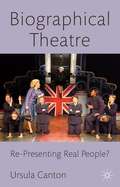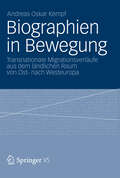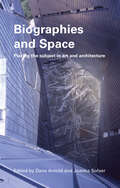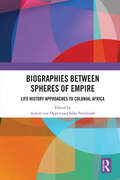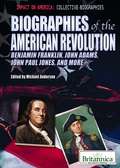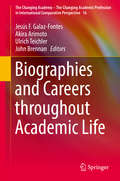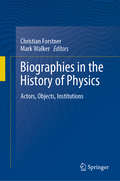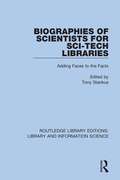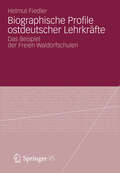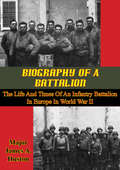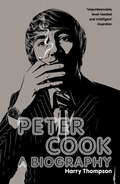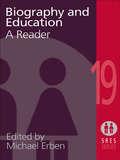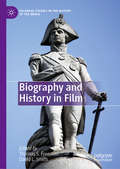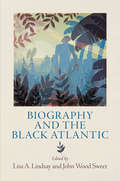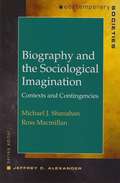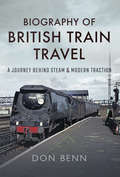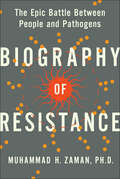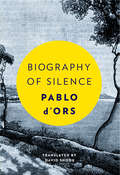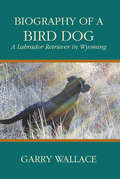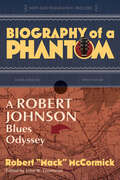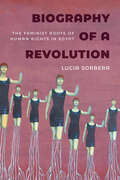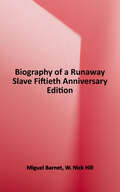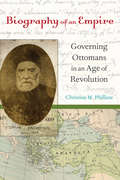- Table View
- List View
Biographical Theatre
by Ursula CantonMarilyn Monroe, Vincent van Gogh or the victims of rendition flights - the number and variety of historical and contemporary figures represented on British stages is amazing. This book develops a new theoretical framework for the representation of real life figures on stage and examines different ways in which they can be included in performances.
Biographien in Bewegung: Transnationale Migrationsverläufe aus dem ländlichen Raum von Ost- nach Westeuropa
by Andreas Oskar KempfAndreas Oskar Kempf behandelt transnationale Migrationsverläufe aus dem ländlichen Raum von Ost- nach Westeuropa mit dem Fokus auf Rumänien und Italien. Er rekonstruiert, in welche biographischen Zusammenhänge die transnationalen Migrationsprozesse eingebettet sind, und arbeitet die handlungsorientierenden Wechselwirkungen zwischen Biographie und Migration in ihrer feldspezifischen Typik auf der Basis von ethnographischen Beobachtungen an den verschiedenen Lebensorten der MigrantInnen sowie extensiven biographischen Fallanalysen heraus. Diese Verknüpfung von Biographieforschung und Ethnographie, im Sinne einer "multi-sited ethnography", gewährt einen präzisen Einblick in die Differenziertheit transnationaler Migrationsprozesse, wie sie sich auf der Ebene des alltäglichen Handelns sowie in biographischen, familialen und lokalen Zusammenhängen im Rahmen (national)staatlicher, ökonomischer und rechtlicher Bedingungen vollziehen.
Biographies & Space: Placing the Subject in Art and Architecture
by Dana Arnold Joanna Sofaer DerevenskiBringing together a collection of high-profile authors, Biographies and Space presents essays exploring the relationship between biography and space and how specific subjects are used as a means of explaining sets of social, cultural and spatial relationships. Biographical methods of historical investigation can bring out the authentic voice of subjects, revealing personal meanings and strategies in space as well as providing a means to analyze relations between the personal and the social. Writing about both actual (architectural) and imagined (pictorial) space, the authors consider issues of gender, childhood, sexuality and race, highlighting an increasing fluidity and interaction between theory, methods and history. Biographies and Space is an original and exciting new book, with direct relevance to both architectural and art history.
Biographies Between Spheres of Empire: Life History Approaches to Colonial Africa
by Achim Von Oppen Silke StrickrodtBiographical research can illuminate imperial and colonial history. This is particularly true of Africa, where empires competed with one another and colonial society was characterised by rigid divisions. In this book, five biographical studies explore how, in the course of their lives, interpreters, landowners, students and traders navigated the boundaries between the various spaces of the colonial world. With a focus on African life worlds, the authors show the disruptions and constraints as well as the new options and forms of mobility that resulted from colonial rule. This book was originally published as a special issue of The Journal of Imperial and Commonwealth Studies.
Biographies Of The American Revolution: Benjamin Franklin, John Adams, John Paul Jones, and More (Impact On America: Collective Biographies)
by Michael AndersonA captivating series that surveys the lives of the political figures and social revolutionaries who shaped early U.S. history includes vibrant images depicting memorable events and individuals, a glossary, explanations of key terms and ideas, and relevant websites and organizations to consult for further reference.
Biographies and Careers throughout Academic Life (The Changing Academy – The Changing Academic Profession in International Comparative Perspective #16)
by John Brennan Ulrich Teichler Akira Arimoto Jesús F. Galaz-FontesThe book draws on the 2007 Changing Academic Profession international survey in order to document the personal characteristics, career trajectories, sense of identity/commitment and job satisfaction of academics in 14 countries with different levels of economic and social development and different higher education systems. With nearly 26,000 academics surveyed in 19 countries (of which 14 are reporting their results in this volume), the empirical basis of the book is the most up-to-date and far-reaching in the area. With major changes taking place both in the local and global contexts of higher education and in the working conditions within individual universities, as exemplified by increasing managerialism and performance-based funding, it is important to consider the impact of these changes on the profiles and working lives of the academic profession across different countries. But it is also important to look at the ways in which the faculty's changing profile impacts on the organisation and management of universities and on the delivery of their central functions. Although not always obvious in the short-term, academic work and its conditions attract, incorporate and promote different types of individuals who, in turn, exert considerable influence on the nature of academic work, higher education institutions and, potentially, society. As faculty members are central to the teaching, research and service enterprise activities of higher education, it is important to understand their personal characteristics, career trajectories, sense of identity and commitment, and job satisfaction. These are central for understanding the academic profession in general and, in particular, the factors affecting their involvement and productivity in the work of their institutions. These are a complex result of a mixture of contextual factors (e. g. the status and regulatory framework of the higher education system, the features and atmosphere of the particular institution) and personal factors (e. g. gender, educational attainment, family background, attitudes to work and broader social values). This book examines the different situations facing the academic profession in individual countries and provides comparative studies of country differences.
Biographies in the History of Physics: Actors, Objects, Institutions
by Mark Walker Christian ForstnerThis book sheds new light on the biographical approach in the history of physics by including the biographies of scientific objects, institutions, and concepts. What is a biography? Can biographies also be written for non-human subjects like scientific instruments, institutions or concepts? The respective chapters of this book discuss these controversial questions using examples from the history of physics. By approaching biography as metaphor, it transcends the boundaries between various perspectives on the history of physics, and enriches our grasp of the past.
Biographies of Scientists for Sci-Tech Libraries: Adding Faces to the Facts (Routledge Library Editions: Library and Information Science #11)
by Tony StankusThis book, first published in 1991, is an invaluable guide to biographies of scientists from a wide variety of scientific fields. The books selected for this highly descriptive bibliography help librarians shatter readers’ stereotypes of scientists as monomaniacal and uninteresting people by providing interesting and provocative titles to capture the interest of students and other readers. The biographies included in this very special bibliography were carefully selected for their humour and human insights to give future scientists encouragement, inspiration, and an understanding of the origins of particular scientific fields. These biographies are unique in that they explore the whole personality of the scientist, giving students a glimpse at the variety and drama of the lives beyond well-known contributions or Nobel prize accomplishments.
Biographische Profile ostdeutscher Lehrkräfte: Das Beispiel der Freien Waldorfschulen
by Helmut FiedlerHelmut Fiedler rekonstruiert Motive und Motivkonstellationen für die Wahl des Lehrerberufs von Ostdeutschen, die in einem (berufs-)biographischen Prozess zur Waldorfpädagogik und Anthroposophie gefunden haben und an Waldorfschulen unterrichten. Den Befragten gelang mit ihren biographischen Ressourcen ein erfolgreicher biographischer Übergang nach 1989/90. Die Suche nach einem neuen Weltbild begann schon zu DDR-Zeiten und war geprägt durch ein Interesse am Mitmenschen, an der Freiheit sowie an einer Pädagogik, in deren Mittelpunkt das Kind steht. Die befragten WaldorflehrerInnen sind engagiert an ihren Schulen tätig und stehen für einen unverkrampften Umgang mit Anthroposophie und Waldorfpädagogik. Die Biographien machen deutlich, dass die Persönlichkeit des Lehrers zentral ist und in der Aus- und Weiterbildung eine größere Rolle spielen sollte.
Biography Of A Battalion: The Life And Times Of An Infantry Battalion In Europe In World War II
by Major James A. HustonDuring World War II, James A Huston served as an operations officer in the 3rd Battalion, 134th Infantry, a unit that helped to liberate or capture dozens of cities across France, Belgium, and Germany. From July 1944 through April 1945, the regiment captured 8,974 prisoners of war and covered over 1,500 combat miles, but lost 10,046 men in the process."Biography of a Battalion" recreates the action and provides an account of the war from one soldier who lived through it.
Biography Of Peter Cook
by Harry ThompsonThere are those who say - and Peter Cook himself was among them - that most of his humour was autobiographical. Others - and Peter Cook himself was among them -contend that this simply isn't the case. The truth, of course, lies somewhere in the middle. Peter Cook made President Kennedy wait in line to see him and visited Elizabeth Taylor in her dressing room. He befriended tramps and fundraised for CND. He was capable of extraordinary kindnesses and occasional cruelties. He helped define comedy and satire for a generation, but ended his life a recluse. Harry Thompson has produced the first ever comprehensive biography of this influential and fascinating subject who came up with some of the funniest sketches and greatest jokes of all time.
Biography Of Peter Cook
by Harry ThompsonThere are those who say - and Peter Cook himself was among them - that most of his humour was autobiographical. Others - and Peter Cook himself was among them -contend that this simply isn't the case. The truth, of course, lies somewhere in the middle. Peter Cook made President Kennedy wait in line to see him and visited Elizabeth Taylor in her dressing room. He befriended tramps and fundraised for CND. He was capable of extraordinary kindnesses and occasional cruelties. He helped define comedy and satire for a generation, but ended his life a recluse. Harry Thompson has produced the first ever comprehensive biography of this influential and fascinating subject who came up with some of the funniest sketches and greatest jokes of all time.
Biography and Education: A Reader (Social Research And Educational Studies)
by Michael ErbenOver recent years biographical studies have gained an increasingly important place in academic study. The two are inextricably linked. Education uses biography in teaching, and in biography, education features strongly as a formative stage in personal development. This book elaborates on the analytical work that has drawn attention to biography and education, and seeks to expand the understanding of lives in educational contexts. Mainstream sociology has been quick to embrace this treatment of individuals as biographical appearances, but it is even more relevant in the field of education.
Biography and History in Film (Palgrave Studies in the History of the Media)
by David L. Smith Thomas S. FreemanThe essays in this volume seek to analyze biographical films as representations of historical individuals and the times in which they lived. To do this, contributors examine the context in which certain biographical films were made, including the state of knowledge about their subjects at that moment, and what these films reveal about the values and purposes of those who created them. This is an original approach to biographical (as opposed to historical) films and one that has so far played little part in the growing literature on historical films. The films discussed here date from the 1920s to the 2010s, and deal with males and females in periods ranging from the Middle Ages to the end of the twentieth century. In the process, the book discusses how biographical films reflect changing attitudes towards issues such as race, gender and sexuality, and examines the influence of these films on popular perceptions of the past. The introduction analyses the nature of biographical films as a genre: it compares and contrasts the nature of biography on film with written biographies, and considers their relationship with the discipline of history. As the first collection of essays on this popular but understudied genre, this book will be of interest to historians as well as those in film and cultural studies.
Biography and the Black Atlantic
by John Wood Sweet Lisa A. LindsayIn Biography and the Black Atlantic, leading historians in the field of Atlantic studies examine the biographies and autobiographies of eighteenth- and nineteenth-century African-descended people and reflect on the opportunities and limitations these life stories present to studies of slavery and the African diaspora. The essays remind us that historical developments like slavery and empire-building were mostly experienced and shaped by men and women outside of the elite political, economic, and military groups whom historians often turn to as sources.Despite the scarcity of written records and other methodological challenges, the contributors to Biography and the Black Atlantic have pieced together vivid glimpses into lives of remarkable, through previously unknown, enslaved and formerly enslaved people who moved, struggled, and endured in different parts of Africa, the Americas, and Europe. From the woman of Fulani origin who made her way from Revolutionary Haiti to Louisiana to the free black American who sailed for Liberia and the former slave from Brazil who became a major slave trader in Angola, these stories render the Atlantic world as a densely and sometimes unpredictably interconnected sphere. Biography and the Black Atlantic demonstrates the power of individual stories to illuminate history: though the life histories recounted here often involved extraordinary achievement and survival against the odds, they also portray the struggle for self-determination and community in the midst of alienation that lies at the heart of the modern condition.Contributors: James T. Campbell, Vincent Carretta, Roquinaldo Ferreira, Jean-Michel Hébrard, Martin Klein, Lloyd S. Kramer, Sheryl Kroen, Jane Landers, Lisa A. Lindsay, Joseph C. Miller, Cassandra Pybus, João José Reis, Rebecca J. Scott, Jon Sensbach, John Wood Sweet.
Biography and the Sociological Imagination: Contexts and Contingencies
by Michael J. Shanahan Ross MacmillanBecause life course sociology is an imaginative framework, Biography and the Sociological Imagination is less about "what we know" about the life course and more about "how to think" about changing societies and aging by drawing on life course ideas. Drawing from the latest research and using stories of real people, Shanahan and Macmillan spur readers to imagine alternative ways of organizing society and the implications of these alternatives for the biography.
Biography of British Train Travel: A Journey Behind Steam & Modern Traction
by Don BennRailway Anthology is a collection of mainly previously unpublished articles and short stories, covering a lifelong interest in railways. It spans a wide spectrum over the years, from the early days in Kent in 1960, through the many hours on the lineside on the Surrey Hills line and the South Western main line, to the last frantic years of steam on the Southern, and the current steam scene, as well as the privileged and exciting times spent riding on the footplate of steam locomotives. It majors on the authors main railway passions of steam locomotives, train running performance, including modern motive power and all matters Southern. Locomotive performance in Europe and a tramway are also included, as is a fascinating minor- and little-visited narrow gauge railway in Southern England, plus heritage traction on the London Underground.The book comprises approximately 350 illustrations, many in colour, as well as contemporary timetable extracts and copies of notebook pages, which cover shed visits in Scotland. Fifty train running logs are included, together with some detailed records of days spent by the linesides of railways when steam was still the predominant motive power in parts of the south.
Biography of Resistance: The Epic Battle Between People and Pathogens
by Muhammad H. ZamanAward-winning Boston University educator and researcher Muhammad H. Zaman provides a chilling look at the rise of antibiotic-resistant superbugs, explaining how we got here and what we must do to address this growing global health crisis.In September 2016, a woman in Nevada became the first known case in the U.S. of a person who died of an infection resistant to every antibiotic available. Her death is the worst nightmare of infectious disease doctors and public health professionals. While bacteria live within us and are essential for our health, some strains can kill us. As bacteria continue to mutate, becoming increasingly resistant to known antibiotics, we are likely to face a public health crisis of unimaginable proportions. “It will be like the great plague of the middle ages, the influenza pandemic of 1918, the AIDS crisis of the 1990s, and the Ebola epidemic of 2014 all combined into a single threat,” Muhammad H. Zaman warns.The Biography of Resistance is Zaman’s riveting and timely look at why and how microbes are becoming superbugs. It is a story of science and evolution that looks to history, culture, attitudes and our own individual choices and collective human behavior. Following the trail of resistant bacteria from previously uncontacted tribes in the Amazon to the isolated islands in the Arctic, from the urban slums of Karachi to the wilderness of the Australian outback, Zaman examines the myriad factors contributing to this unfolding health crisis—including war, greed, natural disasters, and germophobia—to the culprits driving it: pharmaceutical companies, farmers, industrialists, doctors, governments, and ordinary people, all whose choices are pushing us closer to catastrophe.Joining the ranks of acclaimed works like Microbe Hunters, The Emperor of All Maladies, and Spillover, A Biography of Resistance is a riveting and chilling tale from a natural storyteller on the front lines, and a clarion call to address the biggest public health threat of our time.
Biography of Silence: An Essay on Meditation
by Pablo D'OrsA publishing phenomenon in Spain: a moving, lyrical, far-ranging meditation on the deep joys of confronting oneself through silence by a Spanish priest and Zen disciple.With silence increasingly becoming a stranger to us, one man set out to become its intimate: Pablo d'Ors, a Catholic priest whose life was changed by Zen meditation. With disarming honesty and directness, as well as a striking clarity of language, d'Ors shares his struggles as a beginning meditator: the tedium, restlessness, and distraction. But, persevering, the author discovers not only a deep peace and understanding of his true nature, but also that silence, rather than being a retreat from life, offers us an intense engagement with life just as it is. Imbued with a rare beauty, Biography of Silence shows us the deep joy of silence that is available to us all.
Biography of a Bird Dog: A Labrador Retriever in Wyoming
by Garry WallaceAs you might expect, Biography of a Bird Dog is the story of a man and his dog. But it is more than that, it’s a memoir of not only a puppy’s first year of life, but of a middle-aged man’s appraisal of his own life and career in a small town in Wyoming. <P><P> As Ebenezer, his bird dog, is nearing the end of his hunting career, the author decides to add a new puppy to the family, with the intention of using all he has learned to train her to achieve the full potential of her breed, a process that turns out to be filled with both joy and frustration. When tragedy strikes, he must re-evaluate his own plans along with his dog’s future.
Biography of a Phantom: A Robert Johnson Blues Odyssey
by Robert Mack McCormickThe drama of In Cold Blood meets the stylings of a Coen brothers film in this long-lost manuscript from musicologist Robert &“Mack&” McCormick, whose research on blues icon Robert Johnson's mysterious life and death became as much of a myth as the musician himselfWhen blues master Robert Johnson&’s little-known recordings were rereleased to great fanfare in the 1960s, little was known about his life, giving rise to legends that he gained success by selling his soul to the devil. Biography of a Phantom: A Robert Johnson Blues Odyssey is musicologist Mack McCormick's all-consuming search, from the late 1960s until McCormick&’s death in 2015, to uncover Johnson's life story. McCormick spent decades reconstructing Johnson's mysterious life and developing theories about his untimely death at the age of 27, but never made public his discoveries. Biography of a Phantom publishes his compelling work for the first time, including 40 unseen black-and-white photographs documenting his search.While knocking on doors and sleuthing for Johnson's loved ones and friends, McCormick documents a Mississippi landscape ravaged by the racism of paternalistic white landowners and county sheriffs. An editor's preface and afterword from Smithsonian curator John W. Troutman provides context as well as troubling details about McCormick&’s own impact on Johnson&’s family and illuminates through McCormick&’s archive the complex legacy of white male enthusiasts assuming authority over Black people&’s stories and the history of the blues.While Johnson died before achieving widespread recognition, his music took on a life of its own and inspired future generations. Biography of a Phantom, filled with lush descriptive fieldwork and photographs, is an important historical object that deepens the understanding of a stellar musician.
Biography of a Revolution: The Feminist Roots of Human Rights in Egypt
by Dr. Lucia SorberaIt is not Egypt's 2011 revolution that opened a space for women's and feminist activism, but—as this book shows—the long history of women's activism that created the intellectual and political background for revolution. By centering the experiences and ideas of multiple generations of women activists and intellectuals, Lucia Sorbera traces the feminist genealogies of Egypt's nationalist, student, Marxist, labor, human rights, and democratic social movements. Biography of a Revolution gathers a series of interrelated intimate and relational stories, charting in vivid detail the entanglements between women's aspirations across a century of politics and friendships. This historical analysis innovatively deploys decolonial and indigenous feminist epistemologies, bringing women's, gender, and feminist history into the center of Egypt's political, social, and intellectual history. More than a decade after the 2013 military coup, women's intellectual and political activism remains crucial to keeping the embers of revolution aglow.
Biography of a Runaway Slave: Fiftieth Anniversary Edition
by Miguel BarnetFiftieth Anniversary Edition Originally published in 1966, Miguel Barnet's Biography of a Runaway Slave provides the written history of the life of Esteban Montejo, who lived as a slave, as a fugitive in the wilderness, and as a soldier fighting against Spain in the Cuban War of Independence. A new introduction by one of the most preeminent Afro-Hispanic scholars, William Luis, situates Barnet's ethnographic strategy and lyrical narrative style as foundational for the tradition of testimonial fiction in Latin American literature. Barnet recorded his interviews with the 103-year-old Montejo at the onset of the Cuban Revolution. This insurgent's history allows the reader into the folklore and cultural history of Afro-Cubans before and after the abolition of slavery. The book serves as an important contribution to the archive of the black experience in Cuba and as a reminder of the many ways that the present continues to echo the past.
Biography of an Empire
by Christine M. PhilliouThis vividly detailed revisionist history opens a new vista on the great Ottoman Empire in the early nineteenth century, a key period often seen as the eve of Tanzimat westernizing reforms and the beginning of three distinct histories--ethnic nationalism in the Balkans, imperial modernization from Istanbul, and European colonialism in the Middle East. Christine Philliou brilliantly shines a new light on imperial crisis and change in the 1820s and 1830s by unearthing the life of one man. Stephanos Vogorides (1780-1859) was part of a network of Christian elites known phanariots, institutionally excluded from power yet intimately bound up with Ottoman governance. By tracing the contours of the wide-ranging networks--crossing ethnic, religious, and institutional boundaries--in which the phanariots moved, Philliou provides a unique view of Ottoman power and, ultimately, of the Ottoman legacies in the Middle East and Balkans today. What emerges is a wide-angled analysis of governance as a lived experience at a moment in which there was no clear blueprint for power.
